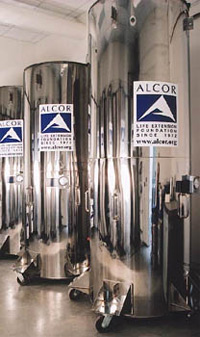Exploring different cultures, and different beliefs when it comes to burials and end of life, is endlessly intriguing. Among modern individuals, there is a cultural trend called cryonics. Cryonics is the process of freezing someone who has died, with hopes that once modern medicine has progressed the person can be revived and treated. The practice stirs up controversy among scientists, and even among family members of those who choose this burial, but there still are many supporters who believe that it will change the future.
Cryonics began as an idea from Robert Ettinger, “The Father of Cryonics.” In 1962, Ettinger published a book titled The Prospect of Immortality, where he explains that with the help and evolution of modern medicine, people can be brought back to life. During the same time, Evan Cooper had also written a book on cryonics, though since it lacked scientific evidence, it was never published. But that did not stop Cooper. He then created the first cryonics organization, the Life Extension Society (LES). When LES first opened, Cooper offered to freeze the first volunteer free of charge. In 1966, after many attempts, Cooper announced that, “Someone has been frozen at last!” Since then, Cryonics has been slowly gaining interest among individuals and scientists.
There are two types of cryonics: neuropreservation and full body preservation. Neuropreservation involves freezing only one’s head with the hopes that when future scientific technology develops, he or she will be able to grow a new body. With the brain frozen, memories and personality live on; the rest of the remains are cremated. However, in a full body preservation, the entire body is frozen. Either processes uses a cryoprotectant—an antifreeze that prevents freezing damage. As time and science have progressed, new and better cryoprotectants have been used.
The controversy is obvious when dealing with cryonics. People think it is unethical, unnatural, and plain creepy. Some people even claim that scientist are trying to play “God.” Cryonics isn’t about making someone immortal; it simply tries to preserve a life that was taken by circumstances that can be treated in the future. The controversy on whether or not it is ethical involves a different definition of “death.” For the purpose of cryonics, death is when someone has legally passed away but is still within a few minutes to a few hours of cardiac arrest.
The process of cryonics can seem as unusual to us, as many other cultural burials are, but cryonics has gathered interest across the world. Cryonics isn’t associated with religion per se, but ALCOR, an organization dealing with cryonics, does offer an explanation that the process of cryonics is part of God’s plan. Since cryonics is so controversial, many people need support from outside individuals to help them decide if it is right for them. All around the world, including the Bay Area, there are meetings where people can talk about their interest in cryonics and similar subjects, or simply find support. There are cryonic support groups in the UK, Australia, Canada, Denmark, Holland, Spain, and various cities throughout the US.
Cryonics is an interesting burial option, one that may not be for everyone. But, as time develops, and science develops, cryonics may be a more popular choice. Since cryonics isn’t associated with a specific religion, or even country, it allows more people to gain an interest in the idea. And it has connected people from different cultures and different countries by giving them a comfortable place to talk about death, dying, and continuing life.
More from Cultural Perspectives:
- The Tulafale’s Role: Samoan Oratorial Traditions for Death and Funeral
- Laying a Pet to Rest: A Short History of Pet Cemeteries
- Restoring Coral Reefs through Sea Burial

 Cryonics: the future of burial
Cryonics: the future of burial




 Having an Estate Plan Is Essential – So Is Discussing It With Your Children
Having an Estate Plan Is Essential – So Is Discussing It With Your Children
 The Healing Sound of Singing Bowls
The Healing Sound of Singing Bowls
 “Summons” by Aurora Levins Morales
“Summons” by Aurora Levins Morales














